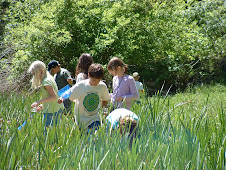“A child said What is the grass?
fetching it to me with full hands,
How could I answer the child?”
~Walt Whitman.
I was reminded of these lines from Walt Whitman’s poem Leaves of Grass yesterday when a student asked me a question during our Earth Studies session.
We were sitting in a circle amongst the Ponerosa Pines examining the soil created by that ecosystem; discussing the minerals, water, air and organic matter to be found in the samples each child had taken. We discussed the ways in which the forest of the past contributed a great deal to the rich, nutritive biotic content of the soil from which the forest of the present receives it's nutrients and water from.
A child held up something he had found in his small sample of soil. “What is this?” he asked. It was one of the small, orange, male pine cones.
I explained what it was, but this answer only served to generate more questions. One was, why are the female cones so much bigger than the male cones?” I explained that the female cone is an ovulate cone and has a big job; it must build a home for, create the seeds which carry all the genetic coding for the Pine tree to reproduce, and must house those seeds until they are dispersed which may take several years.
Often I am asked questions by students during Earth Studies programs to which I would love to answer in great depth and illuminate them at length to the amazing and elegant complexity of the living systems of the world around them. I would have loved to go into how wind tunnel analyses of the female cones have shown that the geometry of the cone’s structure itself aerodynamically enhances the probability of pollen entrapment.
A part of me, akin to Whitman, would love to ruminate on each question, take them deep, ponder and mull over the nuances and connections and through this generate a greater sense of meaning within myself and these children, imbue their worldview with a deep beauty. With the day’s time constraints and the short attention span of the Fifth Graders however, it is best to keep the answers brief and as “on-topic” or applicable to the session’s lesson as possible. Bring it back around. Show interconnectedness.
I woke up this morning with some deeper thoughts on this subject. What we do as Environmental Educators is a lot of seed planting; we know that not all seeds will take root, so we plant a lot. It occurred to me however, that not only are we planting seeds, but we are enriching the soil those seeds are planted in and that this, like the relationship between the soil and the trees in this ecosystem, will perpetuate itself. Environmental Educators not only teach the elements of the session at hand, but as adult members of their community and education system, we teach many other things by example. We show them our love of Nature and how to responsibly interact with our environment and each other. Earth Studies Co-Program Director John Duston once told me "We teach values." and I would have to agree with him wholeheartedly. Much of what we teach is through exhibiting our values by our behavior. We teach them that we value nature and value learning by fostering an outdoor classroom culture of cooperation, mutual respect, patience and enthusiasm. As we educate these young people our hopes are that it elevates the level of education, the sense of place and the values of our community and society at large as it grows and matures. Our intention is that each of these kids grows up strong, healthy, intelligent and happy.
Society is the soil from which our children grow; our children will become the society of the future and they will in turn become the soil from which their children grow.











1 comment:
Wonderful piece, Ranger Pine...so well said. Thanks for being a part of the MPEC team, Dave
Post a Comment